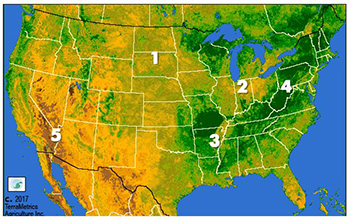Despite large old-crop stocks, traders are watching and reacting to growing-season weather. Planalytics, a weather intelligence company, shared its expectations last week for the remaining growing season. Below are highlights from Planalytics’ forecast:
- Increasing dryness in the Dakotas, Nebraska and Kansas.
- Periods of strong heat in the heartland, but sporadic rain during the weeks of June 28 to July 24, which includes corn silking in many areas.
- Summer characterized by volatile weather, including temperature swings, severe storms and high winds.
Growing conditions so far this year appear most analogous to 1990, 1993, 2006 and 2014, said Jeffrey Doran, Planalytics’ agricultural meteorologist. “These were not low-rainfall years,” Doran said.
Common weather themes include neutral El Nino/La Nina conditions, a positive PDO (Pacific Decadal Oscillation), and intensifying Bermuda High off the East Coast.
“As a result,” Doran said, “we will continue to see strong ridging of high pressure in both the East and West causing upper atmospheric instability over the continent. The interior states will become the battleground between the pulses of heat from the West and the cooler weather and storms brought south by the jet stream.”
Bottom line:
Planalytics forecasts winter wheat yields coming in slightly behind last year’s excellent crop, but above USDA’s current estimate and above trend.
| WINTER WHEAT |
2017 Yield
|
USDA June est.
|
Last year
|
Trend (1989-16)
|
| US |
51.2
|
48.9
|
55.3
|
48.5
|
| Kansas |
46.4
|
44.0
|
57.0
|
42.1
|
| Nebraska |
49.4
|
46.0
|
54.0
|
46.4
|
| South Dakota |
48.0
|
50.0
|
58.0
|
51.3
|
| Wyoming |
34.3
|
---
|
34.0
|
31.6
|
Corn and soybean yields are pegged below last year’s record and slightly below trend.
| CORN |
2017 Yield
|
Last year
|
Trend (1989-16)
|
| US |
166.9
|
174.6
|
168.2
|
| Iowa |
188.9
|
203.0
|
190.3
|
| Kansas |
132.0
|
142.0
|
131.0
|
| Nebraska |
179.0
|
178.0
|
179.1
|
| South Dakota |
143.3
|
161.0
|
152.9
|
| SOYBEANS |
|
|
|
| US |
46.8
|
52.1
|
47.1
|
| Iowa |
53.9
|
60.5
|
53.8
|
| Kansas |
36.6
|
48.0
|
37.5
|
| Nebraska |
57.4
|
61.0
|
57.0
|
| South Dakota |
40.4
|
49.5
|
43.3
|
Late corn planting has pushed corn pollination into the traditionally hottest part of the season. This may have traders on edge, but don’t expect current weather to ignite the market for long, Planalytics advised.
Once crops are known, cash prices and basis patterns may be affected, said Kevin McNew of GeoGrain, which tracks basis at hundreds of locations across the country.
“Corn acreage in the Eastern Corn Belt (ECB) was mainly unchanged from last year, while yields are expected to be better there. Conversely, the Western Corn Belt (WCB) is likely to see more limited yield potential at the same time farmers there planted fewer corn acres compared with last year. As a result, we would expect to see more strength in corn basis in the WCB versus the ECB, which may see more downside risk.”
Planalytics updates its forecasts monthly.

TerraMetrics Agriculture, affiliated with the University of Kansas, employs satellite data to create greenness maps and predict crop yields, which Planalytics, a weather intelligence company, combines with its weather data to provide regularly updated agricultural outlooks during the growing season. The maps for June 6-19 revealed impacts of prevented planting and late emergence of replanted acres in parts of the Corn Belt, in Planalytics’ view.
Here is their commentary on the areas numbered on the map.
1) In the Western Corn Belt, greenness is uneven. Weeks of very dry conditions (less than 10 percent of normal in early June) combined with heat during the same period took a toll on early season growth.
2) Surplus spring moisture in the Eastern Corn Belt led to replanting, then dryness set in. Emergence was late and crop conditions are worse than national ratings.
3) In the Missouri Valley and Delta, biomass is high, on ample soil moisture. Emergence was accelerated, with robust crop health ratings. However, rain from Tropical Storm Cindy was not welcome in some fields.
4) Appalachia and the Northeast are enjoying the same conditions of ample moisture and healthy crops.
5) Greenness in the West was patchy and decreasing in the face of scorching and bone-dry conditions.

